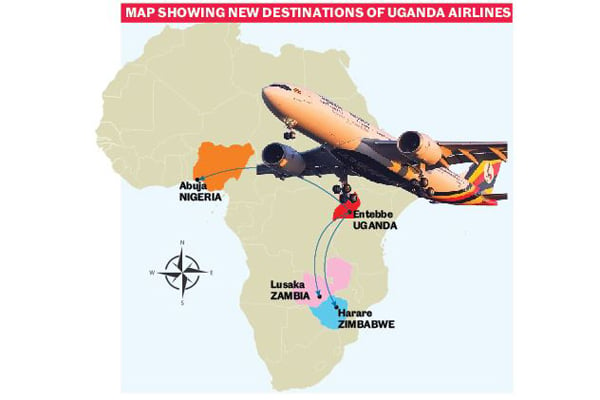Uganda Airlines to mark 5th birthday with new routes

Three new routes. Uganda Airlines will start operating commercial flights to Lusaka in Zambia, Harare in Zimbabwe and Abuja (Nigeria) in September, according to management.
This month, the national carrier, Uganda Airlines will make five years of spreading its wings across the East African region, India, West Africa, and the United Arab Emirates.
The fifth birthday will coincide with the launch of three more routes this week to Abuja in Nigeria, Lusaka, and Harare.
From the first commercial flight to Nairobi, Kenya, on August 19, 2019, the route network now covers 16 destinations, with an additional new three ones to be launched this week.
“We are proud of our contribution thus far. We are not just providing connectivity but also expanding opportunities for business, investment, and leisure travel,” Ms Jenifer Bamuturaki, the chief executive officer of the airline, said last week in an interview.
According to Civil Aviation Authority records, Entebbe International Airport is now connected to 33 airports in 20 countries. However, before Uganda Airlines entered the market, only nine of these countries and airports were served by direct flight.
Starting with a daily service to Nairobi five years ago, Uganda Airlines quickly ramped up its route network to Dar es Salaam, Kilimanjaro, Juba, Mogadishu, and Bujumbura before the Covid-19 pandemic disrupted the global economy and air travel in March 2019.
The carrier was, however, quickly repurposed to play a crucial role in the repatriation of Ugandans who had been left stranded in different parts of Africa.
As Covid-19 travel restrictions eased, route development resumed with the launch of services to Johannesburg in South Africa, Kinshasa in the DR Congo, Dubai in the United Arab Emirates, Mombasa in Kenya, and Zanzibar in Tanzania.
Last October, services to Lagos, Nigeria, and Mumbai in India were launched marking the first time that Uganda is connected to India and West Africa with non-stop flights.
“Our growth has been two-dimensional. Besides route expansion, there has also been frequency growth on individual routes, increasing choice and flexibility for our customers,” Ms Bamuturaki said.
Johannesburg is now served daily, Nairobi 20 times a week, Juba nine times, Kinshasa six times and Bujumbura five times. This has contributed to significant growth in revenues and traffic, with passenger numbers hitting more than one million over the last five years.
Over the coming six months, the carrier is mulling to Accra, Riyadh, and the United Kingdom.
“Despite a challenging environment beset by severe disruption, we look back at the past five years with pride. As we embark on the next five years, we step out with confidence and pledge to deliver the best service to our customers across the customer journey,” Ms Bamuturaki added.
600 direct jobs
In the last five years as the national carrier shakes off its infancy, more than 600 direct jobs have been created with an additional 15,840 indirect ones. That figure is derived from the airlines’ facilitation of tourism, expenditure across the supply chain, and spending by its employees on domestic consumption.
According to the International Air Transport Association IATA, air transport supports 7.7 million jobs in Africa and contributes $63 billion in GDP. While averages vary from country to country. For example, in Kenya, a single direct job in air transport supports 26.4 other jobs across the value chain.
Ms Bamuturaki said with a route network expected to reach 20 destinations by July 2025, the Airlines is poised to spend Shs377 billion ($97 million) on purchases during fiscal 2024-25, representing a huge opportunity for the 200 Ugandan businesses that are registered on the carrier’s supplier database.
Speaking during the inaugural Uganda Airlines suppliers’ forum on June 26, Ms Bamuturaki revealed that the flag carrier intended to grow with its 200 local suppliers by incubating them into formidable businesses that can compete on the global scene.
“We are committed to working with you to expand the range of products that you can supply to us on competitive terms,” Ms Bamuturaki said.
Challenges
Not all has been rosy for the airline that is trying to leave the infancy stage for a proper take-off into the skies.
According to Ms Shakila Rahim Lamar, the head of public relations and corporate affairs of the national carrier, named high cost of operation fuel, maintenance, high wage bills, the rare and expensive skills needed to operate aircraft, regulatory regimes of countries where it has been had to open new routes due to stringent policies as some of the challenges they have faced so far in the five-year journey.
“Uganda has not had an airline for over 20 years, there is a need to hire expatriates to fill gaps where nationals are not able to fill,” Ms Lamar said at the weekend.
She also cited the disruptions by Covid-19 as the other challenges, reasoning that it affected the implementation of the initial projections.
According to the 2022 Auditor General’s report, the company's then two-year losses and the ratios computed indicated that the national carrier was not performing well in terms of profitability.
Further, the report indicated that the airline had an approved staff structure of 953 staff, which are anticipated to effectively and efficiently enable the company to achieve its objectives.
“Out of that approved staffing level, only 502 positions were filled (53 percent) leaving a staffing gap of 451 positions (47 percent) …” the auditor general’s report read.



